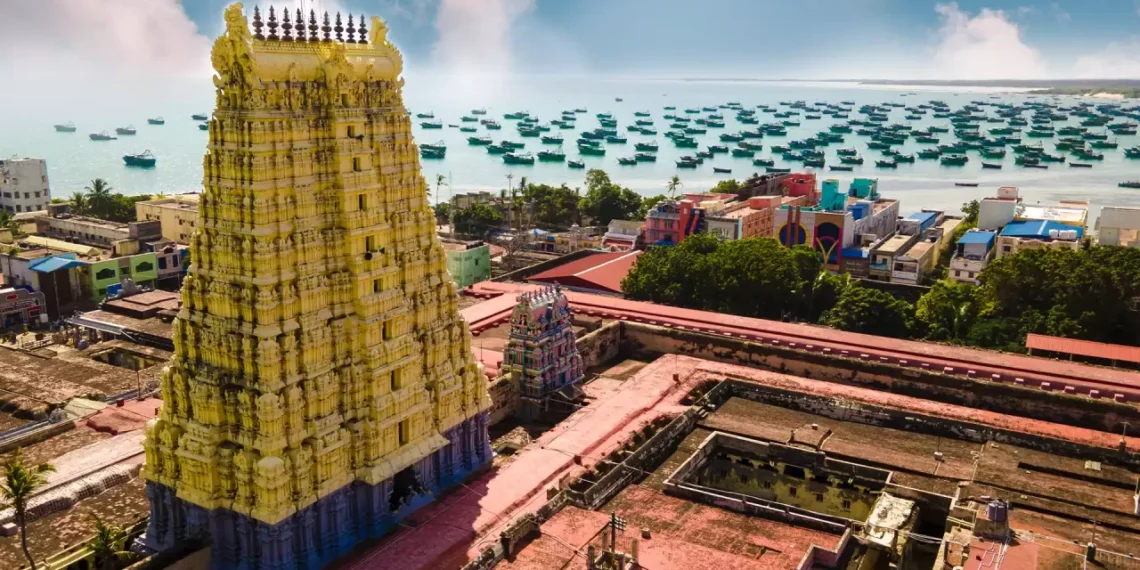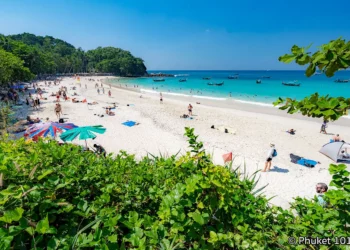The Ramanathaswamy Temple is situated on Rameswaram Island in Tamil Nadu, a holy place for Lord Shiva, worshipped as Ramanathaswamy. It’s one of the 12 Jyotirlinga temples and part of the Char Dham pilgrimage, set by the sea with tall gopurams and long corridors full of prayers and the smell of flowers. Covering 15 acres, it is one of the most famous temple and one of the largest temple complexes in India along with its towering gopurams and wide courtyards. The temple feels alive with the presence of the deity, its stones holding old stories.
Legend of the Temple
The temple’s story comes from the Ramayana. After defeating Ravana, Lord Rama came to Rameswaram with Sita and Lakshmana. Ravana was a Brahmin, so killing him left Rama with a sin. To wash it away, Rama wanted to pray to Shiva with a lingam. He sent Hanuman to get one from Mount Kailash, but even when the right time for worship was near, Hanuman still wasn’t back. Then Mother Sita made a lingam from the beach’s sand, and Rama prayed to it. Shiva blessed it as a Jyotirlinga, called Ramanathaswamy. When Hanuman returned with the Kailash lingam, named Vishwalingam, Rama placed it beside Sita’s and said to honor it first. Both lingams are in the temple now, tied to faith and duty.
Another story says Rama prayed here before building the Ram Setu bridge to Lanka, and Shiva made the place as holy as Varanasi. The temple’s 22 wells, called theerthams, have their own tale: Rama shot an arrow into the ground, and fresh water sprang up on the salty island, a gift believed to clean sins.
Detailed History of Ramanathaswamy Temple
The temple’s history goes back to the 7th century, mentioned in the Tevaram hymns by saints Sambandar and Appar, making it a Paadal Petra Sthalam. Worship here might be older, but the building we see grew from the 12th to 17th centuries. The Chola kings, from the 9th to 13th centuries, started it, giving land and money, as stone writings show. Rajaraja Chola I helped make it a big center. The Pandya kings, around the 13th century, built the sanctum and other parts. Then came the Vijayanagara Empire in the 14th to 16th centuries, taking things up a notch. Krishnadeva Raya, who ruled from 1509 to 1529, kicked off the Rajagopuram—a massive 236-foot tower with 13 tiers, finished later in the 1500s. Records talk about piles of gold, jewels, and fields handed over to the temple, a sign of how much it meant to them. The Nayaks of Madurai followed, adding halls and carvings so detailed you could spend hours just looking at them.
The Sethupathi kings of Ramanathapuram, in the 17th century, added the third corridor, a 4,000-foot stretch, one of the longest in any temple. Their granite pillars show their care. In the 1700s, the French held Rameswaram in 1757, then the British in 1760, and Tippu Sultan in 1790. The temple stayed strong through these changes. By 1855, the British looked after it, and in 1951, Tamil Nadu’s HR&CE Board took over, keeping its ways alive. The temple’s spiritual history lives in the Tevaram and its Ramayana connection, making it a key spot for Saiva faith.
Architecture of the Temple
The Ramanathaswamy Temple is Dravidian style, covering 15 acres. Its main gopuram, 126 feet tall, has carvings of gods and old stories. The third corridor, 4,000 feet long, has over 1,200 granite pillars, each with dancers or deities, leading to the sanctum. The sanctum holds the Ramanathaswamy lingam, said to be Sita’s, and the Vishwalingam from Hanuman. Shrines for Parvati as Parvathavardhini, Ganesha, and Murugan are nearby. The 22 theerthams, like Agni Theertham by the sea, are important, used for bathing before prayers. Some wall carvings from Pandya times show Shiva’s tales, making every corner feel like history.
Religious Significance
For Saivites, the temple is a holy site, a Jyotirlinga and Char Dham stop. The story of Rama’s prayer and Sita’s lingam ties it to cleansing and devotion. The theerthams, named in the Tevaram, draw people to bathe and pray. As a Paadal Petra Sthalam, it’s a big pilgrimage place. People offer flowers or abhishekam in devotion.
Festivals and Rituals
Festivals fill the temple with life. Maha Shivaratri has all-night prayers. Navaratri and Thirukalyana Vaibhavam bring music and processions. The Brahmotsavam, a 10-day festival in March or April, has deities carried in decorated vehicles. Six daily rituals, from morning to night, with priests chanting, keep the temple’s rhythm.
Cultural and Modern Importance
The temple is a big part of Tamil culture. The Tevaram hymns and Ramayana link shape Saiva beliefs. Festivals bring Tamil music and dance, and the carvings show old stories. Today, it draws visitors—Rameswaram is 600 km from Chennai, reachable by train or bus. It’s a place where Tamil Nadu’s past and present meet, where faith and history stay alive.
Conclusion
The Ramanathaswamy Temple is one of the best Shiva temple and can be considered Tamil Nadu’s heart. Its legend of Rama’s devotion to Shiva, its history through kings and changes, its abundant carvings and arts, and the deep Saiva faith and devotion make it a must visit temple.











